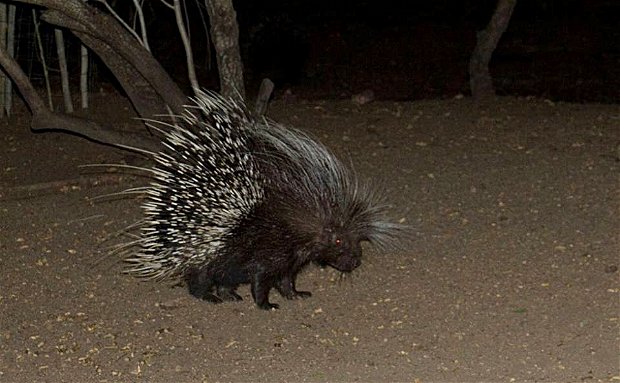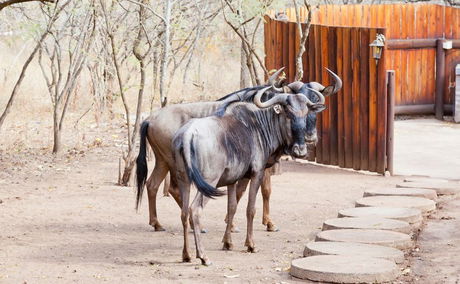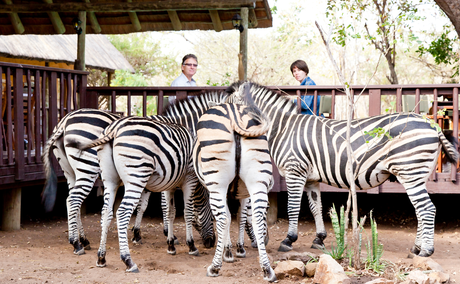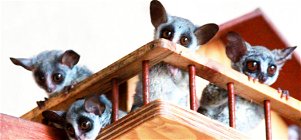Explore the role of wildebeest in Kruger National Park’s ecosystem. Learn about their behaviour, habitat, and their importance in the savanna.
A Prickly Cutie - By “Pango” Lyn Lambert.

Did you know that the Cape Porcupine is the largest rodent in Southern Africa? This species is found throughout southern and central Africa, including South Africa, Kenya, Uganda, and the Congo. And as the official Needles Lodge logo it’s one of our favourite animals!
The Porcupines is a nocturnal, stocky heavily built rodent with short legs weighing about 12 to 24 kgs. They are covered in a coarse fur with most of their hair has modified to form long, sharp quills, which is its defence against predators such as lions, leopards, and hyenas as well as other porcupines. These quills can be between 30cm and 50cm in length and have alternating black and white bands.
The Latin name porcupine, porcus spina, means, “thorn or quill pig,”
Baby porcupines are called porcupettes, and a family unit is called a prickle.
It has long been believed that they shoot their Quills, but this is not true. They in fact raise their quills and rush sideways or backwards and lodging their razor-sharp quills into their “attackers”. They will only do this after giving warning signals if cornered. These signals comprise of stomping their feet, hissing, snorting, and rattling their quills and tail.
They eat mostly plant material such as fruits, roots, tubers, bulbs, and bark, but have also known to gnaw on bones. Local farmers consider them to be pests because they feed on crops and damage trees. However, by debarking of trees they play a part in maintaining ecosystems by helping to reduce the denseness of forest areas.
Have you heard the sounds a porcupine makes? It’s just the cutest sound, like little gremlins talking, when you have a moment try Googling it. Depending on the situation they communicate in various ways using piping calls, grunting, and snuffing noises also tactile communication through a light touch or more aggressive physical contact for mating, competition, or defence as well as chemical communication to scent-mark their feeding areas.
Cape Porcupines are monogamous, occupying up to 6 burrows and mate all year round, although they typically only give birth to 1 litter each year this being during the rainy season (August to January and occasionally stretching through to March). The young, are born after a gestation period of about 3 months, weighing between 300 and 400 grams with both parents sharing the responsibility of raising the young. The mother nurses the porcupettes for 3 to 4 months who are weened in 100 days reaching sexual maturity at about 1 year old.
Unfortunately like many other animals in the wild parts of the porcupine are believed to have medicinal properties Based on traditional mythology, porcupines contain protective powers because of their armour of quills. Their internal organs are burned, ground with herbs and crushed tree barks which is prescribed by traditional healers as medicine to enhance strength and protection against enemies. In the Zulu culture, the quills are occasionally used to make incisions on the skin for applying topical medicines.
Being mostly nocturnal (active at night) they are difficult to see, hence the trail cam picture. Personally, although Kruger has a healthy population, I have not been lucky enough to have seen one in Kruger National Park yet, but I remain hopeful that on one of my trips I will be graced with its presence. So why not join us at Needles Lodge in Marloth Park for your comfortable safari accommodation and join one of our many safari activities in Kruger, maybe you’ll be lucky enough to see one!
Further Reading
Explore the reptiles of Kruger National Park and Marloth Park. Discover geckos, skinks, and chameleons in South Africa’s bushveld habitats.
Discover the fascinating world of zebras in Kruger National Park. Learn about their stripes, social bonds, seasonal movements, and their crucial role in maintaining the savanna ecosystem.






Share This Post